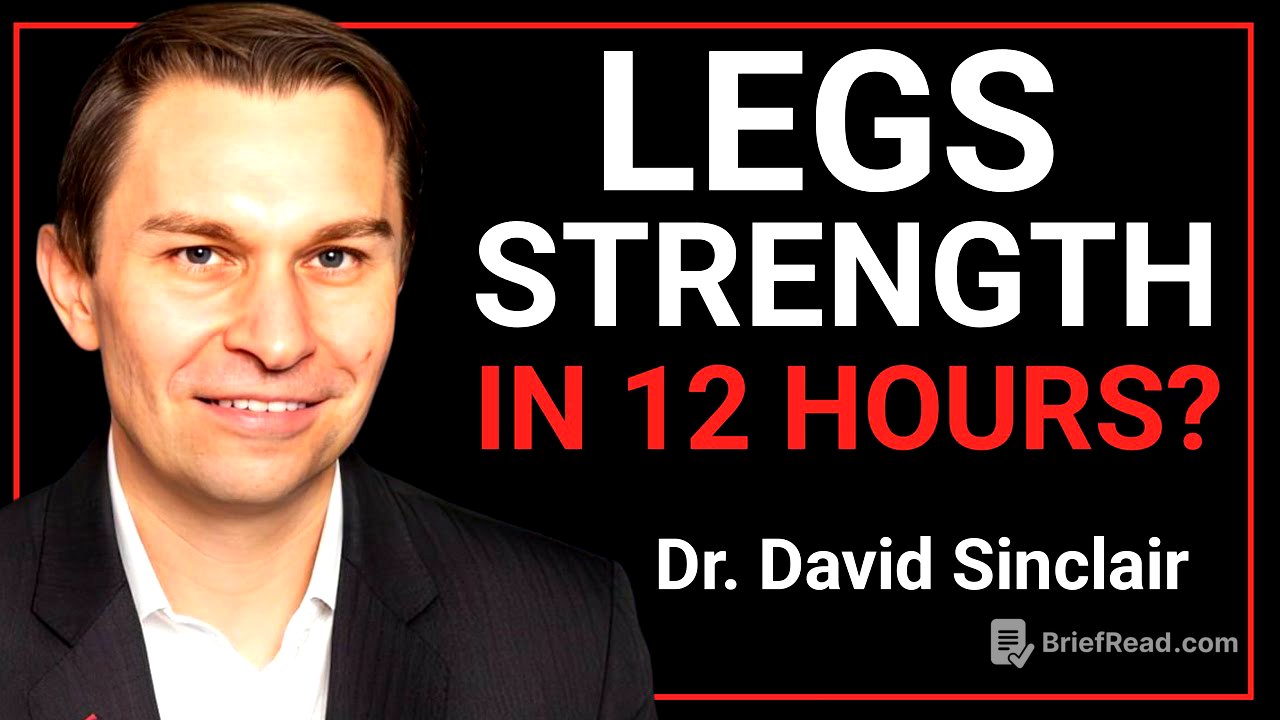TLDR;
This video discusses how consuming beetroot, a natural food rich in dietary nitrates, can rapidly improve leg strength in older adults by boosting nitric oxide levels, which enhances blood flow and mitochondrial function. It emphasizes that aging is a dynamic process that can be influenced by dietary choices and exercise. The key points include:
- Beetroot consumption can lead to a measurable increase in muscle power in the lower limbs within hours.
- Nitric oxide, derived from dietary nitrates, is crucial for vascular health, mitochondrial function, and muscle performance.
- Combining beetroot consumption with resistance training maximizes the benefits for muscle growth and overall vitality.
Introduction & Shocking Truth About Aging [0:00]
The gradual weakening of legs is a significant concern as we age, impacting mobility and predicting frailty and mortality. However, the body retains the capacity to adapt even in later life with the right tools. Consuming beetroot, a simple yet potent intervention, can enhance leg strength in older adults in as little as 12 hours. This improvement isn't just a temporary fix but represents a fundamental biological shift, reawakening pathways impaired by age.
Why Muscle Loss in Legs Predicts Aging [2:10]
Weak leg muscles are strongly linked to a higher risk of fractures and subsequent health declines in old age. Restoring even a fraction of lost strength can have significant benefits for physical performance and overall survival. A study showed that older adults who consumed nitrate-rich beetroot juice experienced a measurable increase in muscle power in their lower limbs within a few hours, specifically around 10% increase in muscle force production.
The Root Cause: Nitric Oxide Decline After 60 [5:45]
Aging is not an inevitable decline but a dynamic process shaped by environmental signals, including diet. Beetroot can trigger rapid and measurable improvements in leg strength, highlighting the plasticity of the aging body. Pharmacological interventions are not the only solution; nature provides compounds that can modulate pathways governing aging and decline.
Meet The Superfood: Beetroot Explained [9:30]
Nitric oxide is a crucial molecule for health, vitality, and longevity, influencing circulation, muscle performance, and metabolic health. As we age, the body's ability to produce nitric oxide diminishes, contributing to vascular stiffness and muscular decline. Dietary nitrates from foods like beetroot can be efficiently converted into nitric oxide, backed by rigorous scientific evidence.
The 12-Hour Leg Strength Boost: Science Behind It [13:20]
Nitrate is first reduced to nitrite by bacteria on the tongue, then further reduced to nitric oxide, especially in low-oxygen conditions like working muscles. Nitric oxide is a vasodilator, relaxing blood vessel walls, improving blood flow, and enhancing oxygen and nutrient delivery to tissues, particularly skeletal muscle. This is especially significant for seniors with impaired endothelial function, as it improves oxygen availability and energy production in muscles.
Mitochondria & Muscle Power: The Sinclair Perspective [18:05]
Mitochondria, the powerhouses of cells, are essential for muscle performance, but their function deteriorates with age. Nitric oxide enhances blood flow and oxygenation, indirectly stimulating mitochondrial activity, allowing muscles to generate more ATP. A single dose of beetroot sets in motion physiological enhancements that recondition the muscle environment, potentially leading to muscle regrowth and improved endurance with regular consumption.
How Nitric Oxide Improves Blood Flow & Oxygen Delivery [21:50]
By the time we reach our 60s, nitric oxide production may have dropped by as much as 50% compared to youthful levels. Nitric oxide is synthesized by an enzyme called nitric oxide synthes (NOS), which converts the amino acid arginine into nitric oxide in the presence of oxygen. This pathway becomes increasingly impaired with age due to oxidative stress, chronic inflammation, and metabolic imbalances.
Combining Beets with Resistance Training for Maximum Results [25:15]
The body interprets signals from the foods we eat and the stresses we place upon it and adapts accordingly. Consuming dietary nitrates enhances nitric oxide production leading to improved blood flow, mitochondrial efficiency and energy availability. Muscle growth and maintenance rely on a principal mechanotransduction, the process by which mechanical stimuli from exercise are converted into biochemical signals that trigger muscle protein synthesis and tissue remodeling.
Daily Routine: How to Consume Beets for Strength [29:30]
The body's production of nitric oxide via the nitrate nitrite pathway depends on a regular supply of dietary nitrates. Incorporating nitrate-rich foods such as beets, spinach, arugula, other leafy greens into the daily diet creates a steady state of nitric oxide availability, maintaining vascular health and muscle function over time. Nitrates improve exercise capacity and exercise enhances endogenous nitric oxide production sustaining vascular health even in the absence of dietary inputs for short periods.
Final Advice from Dr. David Sinclair [33:10]
The decline in muscle strength, especially in the legs, is a fundamental predictor of independence, resilience, and lifespan itself. The use of dietary nitrates, especially from sources like beetroot, represents one of these scientifically validated strategies. Exercise remains potent signal we can send to our bodies that we intend to keep them functioning like they did in youth.
Recap & Action Plan for Seniors [35:40]
Incorporate nitrate-rich foods into your daily routine and move your body daily, prioritizing resistance training. Support these habits with quality sleep, stress management, and whole foods that nourish rather than inflame. Aging is a disease process, slow, cumulative, but modifiable.









